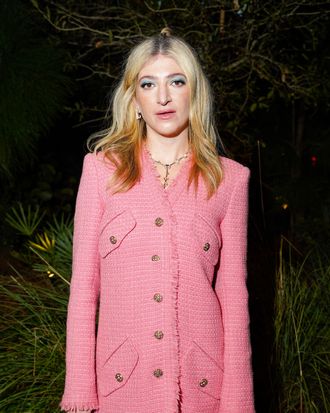
Sarah Hoover first met her husband, the artist Tom Sachs, when she was 23 and working as a gallery assistant. “She was very sassy,” Sachs — who was 41 at the time and famous enough that Hoover had studied his work in school — later recalled in their New York Times “Vows” column. In the years that followed, Hoover made a name for herself in the New York art world, working her way up to become a director at the Gagosian Gallery and popping up at parties in her signature Chanel minidresses. As a couple, she and Sachs are not strangers to controversy. They made headlines in 2023 after Artnet reported they were likely the “Art World Family” behind a viral job listing for an assistant, which was widely ridiculed for its unwieldy and tone-deaf list of responsibilities. A few months later, Sachs apologized following a New York report alleging Sachs ran his studio like a cult and harassed employees, which he denied.
In recent years, Hoover has turned her professional attention to motherhood. After leaving her gallery job to focus on writing, she launched a Substack and gave a few lectures on moms in art history; one such event featured “Margarita Atwood” cocktails and an audience including Emily Ratajkowski and Huma Abedin. After her second child — Winifred “Fred” Sachs — was born last summer, Vogue covered her sip-and-see party.
Hoover’s new memoir, The Motherload: Episodes From the Brink of Motherhood, plumbs the darkness behind this glossy exterior, from her early days dating Sachs to her descent into severe postpartum depression. Hoover’s writing is chatty and intimate, but it’s her compulsive honesty that makes the book hard to put down. You get the sense she couldn’t filter herself if she tried, and she goes much further than the now-standard account of maternal ambivalence.
When Hoover and Sachs get together, she worships him, scheduling her life around his studio schedule and calendar of glitzy parties and vacations. There are some red flags early on, like his habit of keeping in close contact with his exes, but Hoover tries not to think too much about that. She isn’t sure if she wants a baby — growing up, she got the sense that her own mother, the James Beard nominated restaurateur Martha Hoover, found her children a burden. When Hoover gets pregnant, it’s not exactly intentional. “The next time our condom broke,” she writes, “neither of us said a word about Plan B.”
Pregnancy is Hoover’s first indication that motherhood may not be what she signed up for. She hates the nausea, the round ligament pain, the swollen ankles, and the acne. “My quality of life is absolutely zero,” she tells her OB at an early prenatal appointment. But most of all, she hates that her husband seems completely oblivious to how overwhelmed she’s feeling. In a moment of bleak foreshadowing, he breaks down crying when the doctor informs them it wouldn’t be wise to take an impromptu trip to Spain once Hoover’s in her third trimester. Following a traumatic birth — her doctor breaks her water without her consent, leaving her in what she will later recognize as a state of shock — Hoover fixates on the moment she first sees her son. “When they put a baby on my body, I looked down at him, and my heart sank. I felt nothing. No overwhelming love or happiness, not excitement, not even curiosity about him,” she writes. She thinks her baby came out looking like “a malnourished frog” and has trouble finding any upsides to the experience: “I felt like I lost my entire life and identity to this ugly baby in one day.”
Hoover concludes that everything she’s been told about motherhood has been one big lie. Unlike the accounts she reads that make postpartum depression seem like a polite sadness, her experience is defined by uncontrollable rage: at the patriarchy and men in general, but especially at her husband. She’s haunted by nightmares that depict in vivid detail the various ways her baby could die: “he’d be shot by snipers, thrown onto the train tracks, burned up in a house fire.” Hoover’s list of complaints is most unsettling when she describes her difficulty connecting with her baby. She’s preoccupied with his appearance — “all I saw in him were my flaws,” she writes, “my hideous nose, my weak chin” — and she loathes spending time with him. She forces herself to visit his nursery for a “mandated thirty minutes of playtime” a few times a day, feeling her stomach drop with disappointment when she would find him awake. “I would have to interact,” she writes. “Shaking rattles and singing along to nursery songs made me feel like I wanted to unzip my skin and crawl away from it, leaving the outline of myself there to pretend to care.”
Like Hoover, my own entry into motherhood was marked by a mental-health crisis; two weeks after giving birth, I was in the ER with postpartum psychosis. While the specifics of our experiences differ — I was, at least at first, manic, not depressed — I empathized with feeling like a shell of yourself during one of the most monumental transitions of your life. Still, I spent much of the book feeling a bit exasperated. Hoover often seems convinced she’s the only woman in the world to observe that spending time with a newborn isn’t all that fun. And, as she admits, she doesn’t even spend much time with her own. Hoover’s version of motherhood will not look very familiar to anyone without the money to pay for around-the-clock child care. The couple’s nanny, Sharon, sleeps on a daybed in the nursery and accompanies the family on international vacations. Meanwhile, Hoover spends her early days as a mother in bed curled up in the fetal position, hallucinating her baby’s cries and wondering if scheduling a mani-pedi will make her feel better. When she laments her inability to bond with her son, it’s hard not to think that actually learning to take care of him might be a start. (In a scene from her son’s 1st-birthday party — held at Claridge’s hotel in London — Hoover reveals that she still barely knows how to change a diaper.) As a reader, it can be hard to distinguish when Hoover’s behavior is indicative of her spiraling mental health and when she’s just, as she puts it, acting like a “spoiled little fool.”
For most of the first year of her son’s life, Hoover isn’t fully aware of how much she’s struggling. It’s nearly impossible for her to recognize that she may be depressed; instead, she blames herself. “Looking back, the worse things got, the easier it was to believe I was just a bad fit for motherhood.” Hearing about other women’s postpartum experiences only makes her feel more alone. “If they had ‘depression,’ it looked like graceful bouts of weeping sadness on their beds, which didn’t remotely mirror my pockets of rage.” She describes a friend who was so overwhelmed with anxiety that she’d hide with her baby in the bathroom, paranoid that someone would steal him. “Meanwhile, I wanted to give mine away to someone who could parent him better than me.” She rails against the Edinburgh Postnatal Depression Scale — the standard survey women are made to fill out at postpartum check-ups — as irrelevant to her own symptoms. Even when she encounters other mothers talking about going on antidepressants, she’s convinced what she’s experiencing is different.
Sensing that her indifference to her baby is beyond the pale, Hoover keeps the true extent of her symptoms secret, even from her therapist. But even so, it’s hard not to want to shake the people close to her for failing to notice that she was in crisis. Sachs in particular — who Hoover describes taking phone meetings while she’s in active labor and ditching her with the baby to go to his studio as soon as they get home from the hospital — comes across as unforgivably clueless. (He later claims he thought she was just really mad at him.) It’s a relief when, 200 pages into the book, Hoover fires her therapist and finds a better one, who finally tells her she has “a massive and prolonged case of postpartum depression,” advising her to start Zoloft right away.
Considering Hoover’s unsparing bluntness, the book comes to a surprisingly sentimental end. After she catches Sachs texting other women again and begins to consider divorce, he woos her back with a trip to Cuba and a promise to do better. In a scene once her depression has lifted, she gazes at her son adoringly, wondering, “Why had it taken so long to know that’s what you were to me?” She lists many contributing factors — hormones, “Tom’s emotional absence,” “my own immaturity.” But she never really grapples with how her immense privilege may have played a role.
As the mother of young children, I found it nearly impossible to read about Hoover’s 24/7 baby nurse — and the casualness with which the arrangement allows Hoover to drop in and out of her son’s company — without feeling resentment. The despair I felt in my first months postpartum was hard to separate from the fog of sleep deprivation and feeling literally trapped with my baby; there were no spontaneous martinis at Balthazar. Yet the more I read, I realized that I wasn’t actually jealous. Like Hoover, I did not feel fireworks the minute I laid eyes on my children; I was exhausted and had just had my abdomen cut open. That hardly felt significant once they arrived, given that I was spending more hours than I could have imagined feeding them and rocking them to sleep. When her son is born, Hoover’s lack of confidence as a mom leaves her panicked, wondering when her “maternal instincts” will kick in. But as her experience illustrates, the notion that women are natural caregivers is an insidious myth. In reality, the only way to learn how to be a mother is to actually do it.
As the work of a rich white woman writing frankly about the rage she felt becoming a mother, Hoover’s book is destined to be polarizing. But for all her advantages, her experience is devastating. A year is a long time, especially for the mother of an infant. The fact that it took someone with so many resources so long to get a diagnosis and treatment for a condition that an estimated one in seven pregnant women will experience only underscores the problem. It’s probably not the book I’d recommend to someone earnestly wondering what motherhood or postpartum depression is like — but there is something exhilarating about a woman who isn’t afraid of looking like a bad mom.


